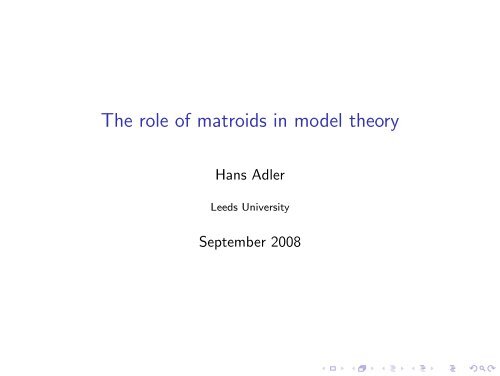The role of matroids in model theory
The role of matroids in model theory
The role of matroids in model theory
Create successful ePaper yourself
Turn your PDF publications into a flip-book with our unique Google optimized e-Paper software.
<strong>The</strong> <strong>role</strong> <strong>of</strong> <strong>matroids</strong> <strong>in</strong> <strong>model</strong> <strong>theory</strong>Hans AdlerLeeds UniversitySeptember 2008
112 CategoricityDef<strong>in</strong>itionA <strong>theory</strong> T is categorical if any two <strong>model</strong>s <strong>of</strong> T are isomorphic.<strong>The</strong>orem (Löwenheim-Skolem)Let T be a countable complete first-order <strong>theory</strong>.If T has <strong>model</strong>s <strong>of</strong> size κ for some <strong>in</strong>f<strong>in</strong>ite card<strong>in</strong>al κ,then T has <strong>model</strong>s <strong>of</strong> size κ for all <strong>in</strong>f<strong>in</strong>ite card<strong>in</strong>als κ.CorollaryLet T be a countable complete first-order <strong>theory</strong>.T is categorical if and only if T has a f<strong>in</strong>ite <strong>model</strong>.
212 κ-categoricityDef<strong>in</strong>itionT is κ-categorical if any two <strong>model</strong>s <strong>of</strong> size κ are isomorphic.<strong>The</strong>orem (Morley)Let T be a countable complete first-order <strong>theory</strong>.If T is κ-categorical for some uncountable card<strong>in</strong>al κ,then T is κ-categorical for all uncountable card<strong>in</strong>als κ.Examples <strong>of</strong> uncountably categorical theories:• Inf<strong>in</strong>ite set with no additional structure.• Vector space over a given f<strong>in</strong>ite (or countable) field.• Projective space over a given f<strong>in</strong>ite (or countable) field.• Algebraically closed field <strong>of</strong> a given characteristic.
312Zilber’s ConjectureExamples <strong>of</strong> uncountably categorical theories:• Inf<strong>in</strong>ite set with no additional structure.• Vector space over a given f<strong>in</strong>ite (or countable) field.• Projective space over a given f<strong>in</strong>ite (or countable) field.• Algebraically closed field <strong>of</strong> a given characteristic.Conjecture (Zilber)Every uncountably categorical countable first-order <strong>theory</strong> isessentially <strong>of</strong> one <strong>of</strong> the above types.Hrushovski found uncountably many counterexamples.
412 MatroidsDef<strong>in</strong>itionA matroid is a set M equipped with a f<strong>in</strong>itary closure operatorcl: P(M) → P(M) that satisfies the exchange property.A ⊆ cl AA ⊆ B =⇒ cl A ⊆ cl Bcl(cl A) = cl Acl A = ⋃ {cl F | F ⊆ f<strong>in</strong>ite A}a ∈ cl(C ∪ {b}) \ cl C =⇒ b ∈ cl(C ∪ {a}).A basis <strong>of</strong> a matroid is a m<strong>in</strong>imal generat<strong>in</strong>g set / maximal<strong>in</strong>dependent set. Its dimension is the card<strong>in</strong>ality <strong>of</strong> any basis.Examples <strong>of</strong> <strong>matroids</strong>:• Trivial closure (i.e. cl A = A) on any set.• L<strong>in</strong>ear hull on a vector space. A matrix.• Algebraic closure on an algebraically closed field.• <strong>The</strong> edges <strong>of</strong> a graph.
612Strong m<strong>in</strong>imalityDef<strong>in</strong>itionA complete first-order <strong>theory</strong> is called strongly m<strong>in</strong>imal if for all<strong>model</strong>s• algebraic closure is a matroid, and• for all n, all <strong>in</strong>dependent n-tuples have the same type.<strong>The</strong>oremLet T be a countable complete first-order <strong>theory</strong>.If T is strongly m<strong>in</strong>imal, then T is uncountably categorical and thecard<strong>in</strong>ality <strong>of</strong> an uncountable <strong>model</strong> equals its dimension.More generally, T is uncountably categorical if and only if therestriction <strong>of</strong> T to a certa<strong>in</strong> formula is strongly m<strong>in</strong>imal and every<strong>model</strong> <strong>of</strong> T is prime over this strongly m<strong>in</strong>imal part.
712Independence for more general theoriesTo extend this dimension <strong>theory</strong> beyond uncountably categoricaltheories, we can:1. drop or weaken the condition on <strong>in</strong>dependent n-types2. generalise the notion <strong>of</strong> matroid, or3. allow other closure operators <strong>in</strong>stead <strong>of</strong> acl.Real closed fields are an example <strong>of</strong> a pregeometric <strong>theory</strong>:Algebraic closure is a matroid. But the <strong>theory</strong> is not uncountablycategorical, and this is an example <strong>of</strong> 1.We will <strong>in</strong>terpret a part <strong>of</strong> the mach<strong>in</strong>ery <strong>of</strong> stability <strong>theory</strong> asdo<strong>in</strong>g 2 <strong>in</strong> order to get 3.
812Semimodular latticesDef<strong>in</strong>ition (Wilcox)(A, B) is a modular pair if for all C ∈ [A ∧ B, B] we have(A ∨ C) ∧ B = C.A lattice is semimodular (M-symmetric) if be<strong>in</strong>g a modular pair isa symmetric relation.• <strong>The</strong> lattice <strong>of</strong> closed sets <strong>of</strong> a matroid is semimodular; theclosures <strong>of</strong> elements are its atoms.• A semimodular lattice that is generated by its atoms can be<strong>in</strong>terpreted as a matroid.
912Independence <strong>in</strong> a semimodular latticeA ⊥ C B ⇐⇒ (A∨C)∧(C∨B) = C, and (A, B) is a modular pair⇐⇒ for all D ∈ [C, B ∨ C]: (A ∨ D) ∧ (B ∨ C) = D.FactIn a matroid, A ⊥ C B is equivalent to the condition that everysubset A 0 ⊂ A which is <strong>in</strong>dependent over C is also <strong>in</strong>dependentover B ∪ C.In an arbitrary semimodular lattice, ⊥ still deserves the name‘<strong>in</strong>dependence’.For example <strong>in</strong> a vector space (or just a module), A ⊥ C B means:A and B are l<strong>in</strong>early <strong>in</strong>dependent over C. In this case the lattice ismodular, so all pairs are modular pairs.
1012 WeightDef<strong>in</strong>itionIn a semimodular lattice, the weight <strong>of</strong> a lattice element A is themaximal n such that there is an <strong>in</strong>dependent sequenceB 0 , B 1 , . . . , B n−1 with A ̸⊥ B 0 , . . . , A ̸⊥ B n−1 .Fact<strong>The</strong> weight 1 elements <strong>of</strong> a semimodular lattice form a matroidunder the follow<strong>in</strong>g closure operator:cl A = {b | ∃A 0 ⊆ A: A 0 <strong>in</strong>dependent and A 0 ̸⊥ b}.If there are ‘enough’ weight 1 elements, and if there is somecontrol over the <strong>in</strong>dependent sets <strong>of</strong> weight 1 elements, then thematroid <strong>of</strong> weight 1 elements helps to understand the <strong>model</strong>s <strong>of</strong> a<strong>theory</strong>. This is the case for superstable theories.
1112 Thorn-fork<strong>in</strong>g• A recent notion due to Scanlon, Onshuus and Ealy.• Equivalent to Shelah’s notion <strong>of</strong> fork<strong>in</strong>g, whenever that iswell-behaved.• More generally well-behaved than fork<strong>in</strong>g.Def<strong>in</strong>itionA |⌣ þ C B iff, up to isomorphism over B ∪ C, acl A ⊥ acl C acl B ′ forall B ′ ⊇ B.A complete first-order <strong>theory</strong> is called rosy if |⌣ þ is symmetric.If a <strong>theory</strong> has a semimodular lattice <strong>of</strong> algebraically closed sets,then the <strong>theory</strong> is rosy.(<strong>The</strong> def<strong>in</strong>ition must be read <strong>in</strong> the monster <strong>model</strong> <strong>of</strong> T eq .)
1212Outlook: Dependent theoriesDef<strong>in</strong>itionA complete first-order <strong>theory</strong> is said to be dependent or NIP if allformulas have bounded Vapnik-Chervonenkis dimension.• This class <strong>in</strong>cludes all stable theories.• Current research <strong>in</strong> <strong>model</strong> <strong>theory</strong> concentrates on unstable case.• Fork<strong>in</strong>g seems to be important here, although it is not symmetric.• If there is a suitable generalisation <strong>of</strong> <strong>matroids</strong> for this situation,it will probably not be symmetric, either.• Greedoids seem to be a natural candidate.
















